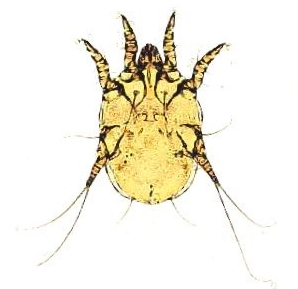ear mites in dogs
What are ear mites in dogs?
Ear mites, medical name otodectes cynotis, are small spider-like creatures that live in the ears of dogs and cats and cause itching, irritation and infection of the ears. Ear mites are very common, especially in young animals.
What causes ear mites?
Ear mites are highly transferable. Mites are mainly transferred through direct contact with other infected animals. Low resistance can cause a dog to experience more complaints more quickly.
What are the symptoms of ear mites?
A common phenomenon in dogs with ear mites is that the dog scratches its ears a lot and shakes its head. Ear mites cause a lot of itching. We also often see a large amount of dark earwax with an ear mite infection. A dog infected with ear mites can get a painful ear infection in which the inside of the ears are (often) red and painful to the touch. The dog also sometimes holds its head to one side.
Are ear mites in dogs contagious?

Ear mites are highly contagious between animals. Young animals are particularly susceptible. Ear mites are transmitted from one animal to another through direct contact.
Ear mites can also be contagious to humans, but this only occurs in very exceptional cases. In humans, it can cause itching on the arms and torso.
How do we diagnose ear mites?
Fortunately, ear mites are easy to recognize. By looking into your pet’s ear with an otoscope, the vet can often see them. In addition, the vet will use a cotton swab to take some earwax from the ear and then examine it under a microscope to be able to diagnose ear mites with certainty.
What is the treatment for ear mites?
Ear mites are treated by administering a pipette in the neck (Advocate/Stronghold). These pipettes work against ear mites, but also against fur mites, fleas and some worms. In addition, it may sometimes be necessary to clean the ear canal to remove excess earwax. If there is an additional infection, an ointment is often used for this.
Do you have a pet with an ear mite infection and do you have multiple animals in the house? Then it is wise to treat them all. An animal can have ear mites without showing symptoms. If they are not treated, there is a chance that they will continue to infect each other.
Can you treat ear mites in your dog yourself?

When your vet has diagnosed your dog with ear mites, treatment will be started. You can perform this treatment at home. Treat any other animals in the house and wash your dog well to remove any mites in the coat.
If you suspect your dog of having ear mites, always have this checked by your vet first. We advise against starting a treatment yourself.
When you search the internet for information, you will probably come across articles advising you to use vinegar and olive oil to treat ear mites. Please be careful with this, as these products can actually cause or worsen problems. You can administer pipettes to your pet yourself, but follow the instructions carefully.
Can ear mites be prevented?
Completely preventing ear mites is difficult, given the high level of infection. However, you can check your dog’s ears once a week. Redness, a lot of earwax or a dirty, unusual odor can indicate ear problems. This is especially advisable for breeds with hanging and hairy ears. You can also clean your dog’s ears every now and then. Use a mild ear cleaner that has been specially developed for dogs. Remove any dirt that comes loose with a cotton ball or cloth. Never use a cotton swab. This often only moves the dirt deeper into the ear.
If you have any questions about this topic, please do not hesitate to contact us!

Stop by for an adolescent consultation!
Is your dog around 6 months old, and would you like to know if everything is developing as it should? Then make an appointment for an adolescent consultation

